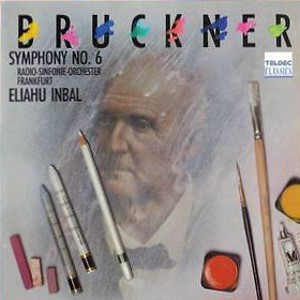 |
|
1 LP -
6.44251 AZ - (p) 1989
|
 |
| 1 CD -
8.44251 ZK - (p) 1989 |
|
| ANTON BRUCKNER
(1824-1896) |
|
|
|
|
|
| Symphonie
Nr. 6 A-dur - Komp.: 1879-1881 |
58' 56" |
|
| -
Majestoso |
17' 51" |
|
| -
Adagio. Sehr feierlich |
17' 03" |
|
| -
Scherzo: Nicht schnell - Trio:
Langsam |
8' 32" |
|
|
|
|
| Radio-Sinfonie-Orchester
Frankfurt |
|
| Elihau Inbal,
Leitung |
|
|
|
|
|
Luogo
e data di registrazione |
|
Alte
Oper, Frankfurt (Germania) -
settembre 1988
|
|
|
Registrazione:
live / studio |
|
studio |
|
|
Producer /
Engineer |
|
Wolfgang
Mohr - Hans Bernhard Bätzing /
Detlef Kittler (HR) - Martin
Fouqué
|
|
|
Prima Edizione LP |
|
Teldec
- 6.44251 AZ - (1 LP) - durata 58'
56" - (p) 1989 - Digitale |
|
|
Prima Edizione CD |
|
Teldec
- 8.44251 ZK - (1 CD) - durata 58'
56" - (p) 1989 - DDD |
|
|
Note |
|
Co-Produktion
mit dem HR Franfurt.
|
|
|
|
|
On 25th
November 1875 ANTON BRUCKNER
drafted his inaugural
lecture for his appointment
to the teaching staff of
Vienna University. In it we
read: "As
you will be aware from a
variety of sources, music
has made such gigantic
progress in the last two
hundred years, it has
expanded and rounded off its
inner organism to such an
extent, that the present-day
observer of this wealth of
material finds himself
confronted with a perfectly
constructed building. The
structure of this building
and the relation of its
different parts to the whole
show a certain regularity
and follow certain laws: we
can see how one part
proceeds from another, how
one element cannot exist
without the other, and yet
each forms a whole in its
own right." These lines are
of considerable interest,
revealing as they do the
altogether harmonic and
self-sufficient view of art
of a man interested in
organic growth, who is one
of the truly tragic figures
in the modern musical
landscape from a
biographical point of view.
Bruckner was a thoroughly
introverted and deeply
religious person, for whom
God and art lay
asymptotically close to one
another. Few musical
personalities of the 19th
century aroused as much
animosity as Bruckner, and
it is not without a certain
fatality that no lesser
figure than Brahms played a
signal role in the attacks
on this modest composer.
Brahm’s silly reference to
Bruckner’s “huge symphonic
serpents" (1897) was one of
the smallest injuries
Bruckner had to suffer. But
it was Bruckner himself who
contributed so lastingly to
the development of the
“perfectly constructed
building” that his works,
regardless of all personal
and historical
circumstances, are among the
most colossal ever produced
by the Western mind. Nor is
the size of these symphonies
achieved at the expense of
dignity - Bruckner balances
the two in fascinating
manner.
The SYMPHONY NO. 6 IN A
MAJOR was composed between
September 1879 and September
1881. Only the second and
third movements were
actually performed during
the composer’s lifetime - on
11th February 1883 as part
of a Vienna Philharmonic
concert conducted by Wilhelm
Jahn. The critics, Eduard
Hanslick at their head, were
once again hostile, but the
audience accorded the work a
warm reception. The Sixth
was performed in full for
the first time albeit with
unauthorized cuts, on 26th
February 1899 by the Vienna
Philharmonic under no less a
baton than that of Gustav Mahler.
The first printing followed
in 1901, although this did
not reproduce Bruckner’s
original score in full. The
composer's autograph score
was not published until
1937, when it appeared in an
edition by the great
Bruckner scholar Robert Haas
- in all respects a fate
typical of Bruckner’s works.
The four-movement
symphony plays for a full
hour; Bruckner dedicated it
to Frau and Herr von
Oelzelt-Nevin as thanks for
rent-free accomodation. The
Sixth is among the
composer's most concentrated
works, and was the product
of the transition from the
monumental Fifth to the
serenity of the last three
symphonies. The thematic
substance is strongly
linked, and this lends the
work a special unity.
The opening movement, Majestoso,
is in sonata form with three
thematic groups. The second
movement, Adagio - sehr
feierlich, is likewise
composed in sonata form with
three thematic groups; in
contrast to the erratic
diction of its predecessor,
however, it shows the
mystical, transcendental
dimension of Bruckner’s
personality. The adagio is
followed by a typical
Bruckner scherzo nothing
short of demonic in style.
Its main key is A minor,
with the original trio set
in the parallel major key of
C major. The fourth and
final movement, Bewegt, doch
nicht zu schnell, is once
again written in sonata
form. Three thematic groups
refer back to the first
movement in the course of
this movement with its
remarkably ingenious
colouring. Bruckner’s
instrumentation is
exceptionally rich: the work
is scored for two each of
flutes, oboes, clarinets and
bassoons; four horns, three
trumpets and three
trombones, bass tuba, timpani and
strings.
Looking at, or rather
listening to this grandiose
musical structure, it seems
impossible to comprehend
with what “infernal
deep-rooted hatred” (Loerke)
a man as upright and sincere
as Bruckner was persecuted
as long as he lived. But
Bruckner himself knew only
too well what he was doing:
in his own words, “If
what I write
is good, it will endure..."
Knut Franke
Translation:
Clive Williams
|
|
|